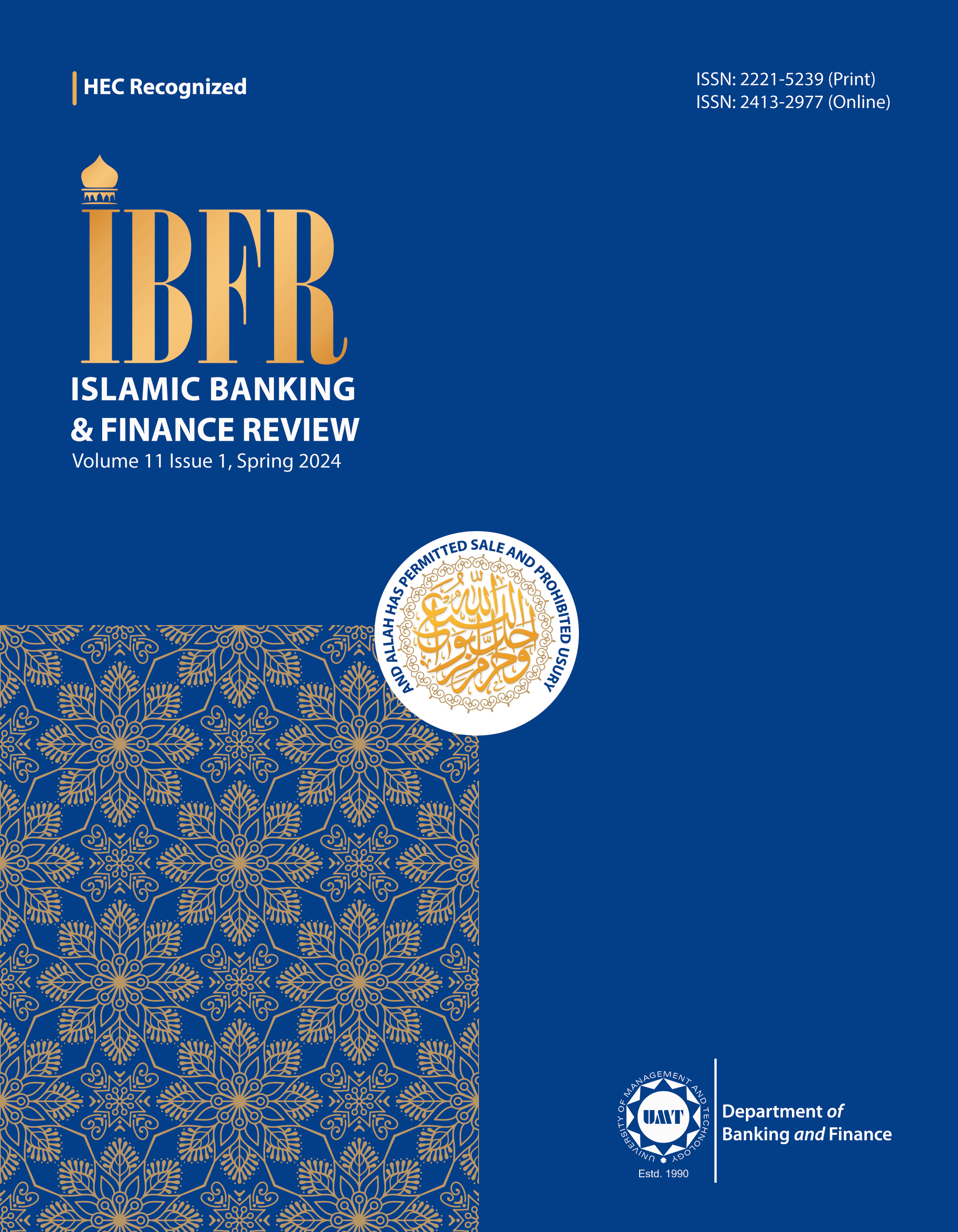Macroeconomic Conditions as Determinants of Profitability and Risk: A Comparison of Islamic and Conventional Banks in Pakistan
Abstract
 Abstract Views: 0
Abstract Views: 0
The current study aims to investigate the association between macroeconomic factors and Islamic and conventional banks’ profitability, technical efficiency, and credit risk in the context of Pakistan. The sample size comprised four (4) Islamic banks and four (4) conventional banks in Pakistan. Data was collected for a period of ten (10) years (2009-2018). To calculate technical efficiency, Data Envelopment Analysis (DEA) method was employed. Profitability was measured through Return on Assets (ROA) and credit risk through Debt to Asset Ratio (DAR). The results of regression estimation showed that generally, all economic variables had the same impact on both Islamic and conventional banks’ profitability, efficiency, and credit risk. However, interest rate showed an opposite impact on both bank types. It was found that interest rate improves the profitability of conventional banks, while it has an adverse impact on Islamic banks’ profitability. Moreover, interest rate improves the efficiency and increases the risk incurred by conventional banks, whereas its impact on the efficiency and risk of Islamic banks is not significant. The current study reveals certain differences in how these institutions respond to macroeconomic conditions. It helps to highlight the resilience or vulnerability of each banking system to economic fluctuations, providing practical implications for policymakers and practitioners both in Pakistan and in other Islamic finance markets.
Downloads
References
Alharbi, A. T. (2017). Determinants of Islamic banks’ profitability: international evidence. International Journal of Islamic and Middle Eastern Finance and Management, 10(3), 331–350. https://doi.org/10.1108/IMEFM-12-2015-0161
Ali, K., Akhtar, M. F., & Ahmed, H. Z. (2011). Bank-specific and macroeconomic indicators of profitability-empirical evidence from the commercial banks of Pakistan. International Journal of Business and Social Science, 2(6), 235–242.
Al-Qudah, A. M., & Jaradat, M. A. (2013). The impact of macroeconomic variables and banks characteristics on Jordanian Islamic banks profitability: Empirical evidence. International Business Research, 6(10), 153–162. http://dx.doi.org/10.5539/ibr.v6n10p153
Anbar, A., & Alper, D. (2011). Bank specific and macroeconomic determinants of commercial bank profitability: Empirical evidence from Turkey. Business and Economics Research Journal, 2(2), 139–152.
Arias, J. C. (2011). Banking profitability determinants. Business Intelligence Journal, 4(2), 209–230.
Ariss, R. T. (2010). Competitive conditions in Islamic and conventional banking: A global perspective. Review of Financial Economics, 19(3), 101–108. https://doi.org/10.1016/j.rfe.2010.03.002
Athanasoglou, P. P., Daniilidis, I., & Delis, M. D. (2014). Bank procyclicality and output: Issues and policies. Journal of Economics and Business, 72, 58–83. https://doi.org/10.1016/j.jeconbus.2013.10.003
Badreldin, A. M. (2009). Measuring the performance of Islamic banks by adapting conventional ratios (Working Paper No. 16). German University in Cairo. https://web.archive.org/web/20170810034549id_/http://mgt.guc.edu.eg/wpapers/016badreldin2009.pdf
Banker, R. D., & Natarajan, R. (2011). Statistical tests based on DEA efficiency scores. In W. Cooper, L. Seiford & J. Zhu (Eds.), Handbook on data envelopment analysis. international series in operations research & management science (Vol. 164, pp. 273–295). Springer. https://doi.org/10.1007/978-1-4419-6151-8_11
Battaglia, F., Farina, V., Fiordelisi, F., & Ricci, O. (2010). The efficiency of cooperative banks: the impact of environmental economic conditions. Applied Financial Economics, 20(17), 1363–1376. https://doi.org/10.1080/09603107.2010.491442
Berger, A. N., Hasan, I., & Klapper, L. F. (2004). Further evidence on the link between finance and growth: An international analysis of community banking and economic performance. Journal of Financial Services Research, 25(2), 169–202. https://doi.org/10.1023/B:FINA.0000020659.33510.b7
Caglayan, M., & Xu, B. (2016). Inflation volatility effects on the allocation of bank loans. Journal of Financial Stability, 24, 27–39. https://doi.org/10.1016/j.jfs.2016.04.008
Charnes, A., Cooper, W. W., & Rhodes, E. (1978). Measuring the efficiency of decision making units. European Journal of Operational Research, 2(6), 429–444. https://doi.org/10.1016/0377-2217(78)90138-8
Chen, Y. K., Shen, C. H., Kao, L., & Yeh, C. Y. (2018). Bank liquidity risk and performance. Review of Pacific Basin Financial Markets and Policies, 21(1), Article e1850007. https://doi.org/10.1142/S0219091518500078
Demsetz, R. S., Saidenberg, M. R., & Strahan, P. E. (1997). Agency problems and risk taking at banks. Federal Reserve Bank of New York. https://web.archive.org/web/20101206104324id_/http://www.newyorkfed.org/research/staff_reports/sr29.pdf
Derbali, A. (2021). Determinants of the performance of Moroccan banks. Journal of Business and Socio-Economic Development, 1(1), 102–117. https://doi.org/10.1108/JBSED-01-2021-0003
Fazio, D. M., Tabak, B. M., & Cajueiro, D. O. (2015). Inflation targeting: Is IT to blame for banking system instability? Journal of Banking & Finance, 59, 76–97. https://doi.org/10.1016/j.jbankfin.2015.05.016
Hakenes, H., & Schnabel, I. (2011). Bank size and risk-taking under Basel II. Journal of Banking & Finance, 35(6), 1436–1449. https://doi.org/10.1016/j.jbankfin.2010.10.031
Hussain, K., & Muhammad, M. (2022). Performance of Islamic and conventional banks: The impact of basel iii. Journal of Islamic Business and Management, 12(1), 32–48. https://doi.org/10.26501/jibm/2022.1201-004
Javaid, S., Anwar, J., Zaman, K., & Ghafoor, A. (2011). Determinants of bank profitability in Pakistan: Internal factor analysis. Yaşar Üniversitesi E-Dergisi, 23(6), 3794–3804.
Javed, M. A., & Basheer, M. F. (2017). Impact of external factors on bank profitability. EPRA International Journal of Research and Development, 2(5), 1–11.
Jreisat, A. (2020). Credit risk, economic growth and profitability of banks. International Journal of Economics and Business Research, 20(2), 152–167. https://doi.org/10.1504/IJEBR.2020.109150
Kanwal, S., & Nadeem, M. (2013). The impact of macroeconomic variables on the profitability of listed commercial banks in Pakistan. European Journal of Business and Social Sciences, 2(9), 186–201.
Kasri, R. A., & Azzahra, C. (2020). Do Islamic banks more stable than conventional banks? Evidence from Indonesia. Journal Ekonomi & Keuangan Islam, 6(2), 149–164. https://doi.org/10.20885/jeki.vol6.iss2.art6
Khemakhem, S., & Boujelbene, Y. (2015). Credit risk prediction: A comparative study between discriminant analysis and the neural network approach. Accounting and Management Information Systems, 14(1), 60–78.
Klein, P. O., & Weill, L. (2022). Bank profitability and economic growth. The Quarterly Review of Economics and Finance, 84, 183–199.
Lee, K. H., & Ullah, S. (2011). Customers' attitude toward Islamic banking in Pakistan. International Journal of Islamic and Middle Eastern Finance and Management, 4(2), 131–145. https://doi.org/10.1108/17538391111144524
Lin, H. Y., Farhani, N. H., & Koo, M. (2016). The impact of macroeconomic factors on credit risk in conventional banks and Islamic banks: Evidence from Indonesia. International Journal of Financial Research, 7(4), 105–116.
Michael, E. I. (2020). An assessment of macroeconomic determinants of bank lending in Nigeria. African Journal of Economics, 1(1), 1–20.
Mifrahi, M. N., & Fakhrunnas, F. (2018). Indonesian Islamic bank’s peformance under Maqāṣid based performance evaluation model (MPEM). Jurnal Ekonomi & Keuangan Islam, 4(2), 93–103.
Nasserinia, A., Ariff, M., & Fan-Fah, C. (2014). Key determinants of Japanese commercial banks performance. Pertanika Journal of Social Science and Humanities, 22(1), 17–38.
Neely, M. C., & Wheelock, D. C. (1997). Why does bank performance vary across states? Federal Reserve Bank of St. Louis Review, 79(2), 27–40. https://doi.org/10.20955/r.79.27-40
Oino, I. (2021). Regulatory capital: Implications on credit creation and profitability. Cogent Economics & Finance, 9(1), Article e1955470. https://doi.org/10.1080/23322039.2021.1955470
Simiyu, C. N., & Ngile, L. (2015). Effect of macroeconomic variables on profitability of commercial banks listed in the Nairobi securities exchange. International Journal of Economics, Commerce and Management, 3(4), 1–16.
Tabash, M. I., & Dhankar, R. S. (2014). The impact of global financial crisis on the stability of Islamic banks: Empirical evidence. Journal of Islamic Banking and Finance, 2(1), 367–388.
Terraza, V. (2015). The effect of bank size on risk ratios: Implications of banks’ performance. Procedia Economics and Finance, 30, 903–909. https://doi.org/10.1016/S2212-5671(15)01340-4
Turner, A. (2012). Credit creation and social optimality. International Review of Financial Analysis, 25, 142–153. https://doi.org/10.1016/j.irfa.2012.09.004
van Greuning, H., & Iqbal, Z. (2008). Risk analysis for Islamic banks. World Bank Publications. https://documents1.worldbank.org/curated/en/688471468143973824/pdf/424810PUB00ISB101OFFICIAL0USE0ONLY1.pdf
Waemustafa, W., & Sukri, S. (2015). Bank specific and macroeconomics dynamic determinants of credit risk in Islamic banks and conventional banks. International Journal of Economics and Financial Issues, 5(2), 476–481.
Wong, J., Fong, T. P. W., Wong, E. T. C., & Choi, K. F. (2008). Determinants of the performance of banks in Hong Kong. In H. Genberg & C.-H. Hui (Eds.), The banking sector in Hong Kong: Competition, efficiency, performance and risk (pp. 50–65). Springer.
Yu, M., Feng, Z., & Wang, Y. (2022). The business cycles driven by loan defaults via credit creation: An agent-based perspective. Finance Research Letters, 48, Article e102846. https://doi.org/10.1016/j.frl.2022.102846
Zainol, Z., & Kassim, S. H. (2010). An analysis of Islamic banks’ exposure to rate of return risk. Journal of economic Cooperation and Development, 31(1), 59–84.
Zheka, V. (2005). Corporate governance, ownership structure and corporate efficiency: The case of Ukraine. Managerial and Decision Economics, 26(7), 451–460.
Copyright (c) 2024 Khalid Hussain

This work is licensed under a Creative Commons Attribution 4.0 International License.
Authors retain copyright and grant the journal right of first publication with the work simultaneously licensed under a Creative Commons Attribution (CC-BY) 4.0 License that allows others to share the work with an acknowledgement of the work’s authorship and initial publication in this journal.












